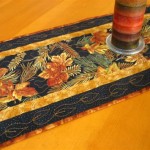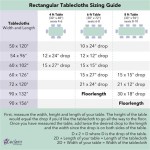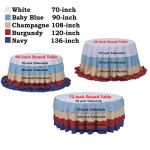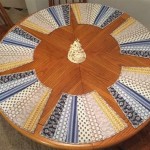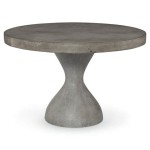What Size Rug Under an 8-Seat Dining Table: A Comprehensive Guide
Selecting the appropriate rug size for under an 8-seat dining table requires careful consideration of both aesthetics and functionality. The rug serves as a visual anchor, defining the dining space and adding warmth and texture. However, a rug that is too small can make the room feel disjointed, while one that is too large can overwhelm the space. This article provides a comprehensive guide to determining the ideal rug size for an 8-seat dining table, ensuring a harmonious and practical dining area.
The primary goal when selecting a rug for under a dining table is to ensure that all chairs remain on the rug even when pulled out from the table. This prevents chairs from catching on the edge of the rug, creating a tripping hazard and potentially damaging both the chairs and the flooring. Furthermore, a sufficient rug size provides a more comfortable and visually appealing dining experience.
Key Considerations for Determining Rug Size
Several factors influence the ideal rug size for an 8-seat dining table. These include the dimensions of the table itself, the size of the dining room, and the desired aesthetic. Understanding these factors will help in making an informed decision.
Table Dimensions: The dimensions of the dining table are the most critical factor in determining the rug size. An 8-seat dining table typically ranges from 72 to 96 inches in length and 36 to 48 inches in width. However, it is important to measure the specific table to ensure accurate rug selection. Once the table dimensions are known, an additional allowance must be calculated for chair movement.
Chair Movement Allowance: As a general rule, allow for at least 24 inches, and preferably 30-36 inches, of rug extending beyond the table's edge on all sides. This allowance provides ample space for chairs to be pulled out without sliding off the rug. The 24-inch minimum is a good guideline for smaller spaces, while the 30-36 inch allowance is preferable for larger rooms where a more generous rug will enhance the overall aesthetic.
Room Size: The size of the dining room relative to the table and rug is also crucial. In a smaller dining room, a rug that is too large can make the space feel cramped. Conversely, in a larger dining room, a rug that is too small can appear insignificant and fail to anchor the dining area effectively. Ideally, there should be at least 18-24 inches of exposed flooring around the perimeter of the rug to avoid a wall-to-wall carpet effect which can make the room feel smaller.
Room Shape: The shape of the dining room can also influence rug selection. In a square or rectangular room, a rectangular or square rug is typically the most appropriate choice. In a room with irregular dimensions, an oval or round rug can help to soften the angles and create a more cohesive look. The rug shape should ideally mirror the shape of the table for continuity, but that isn't always possible depending on the floor space available.
Traffic Patterns: Consider the primary traffic patterns in the dining room. If people frequently walk around the dining table, the rug should be large enough to accommodate this traffic. A rug that is too small can create a tripping hazard and disrupt the flow of movement. The rug should extend far enough beyond the chairs that diners and guests are not stepping on and off the rug frequently throughout the meal. This provides for a more comfortable and stable experience.
Calculating the Ideal Rug Size
Based on the guidelines above, calculating the ideal rug size for an 8-seat dining table involves a simple formula. First, measure the length and width of the table. Then, add the desired chair movement allowance (24-36 inches) to each dimension. The resulting figures represent the minimum and preferred rug dimensions.
For example, if an 8-seat dining table is 72 inches long and 36 inches wide, the following calculations apply:
Minimum Rug Length: 72 inches (table length) + 24 inches (chair allowance) + 24 inches (chair allowance) = 120 inches (10 feet)
Minimum Rug Width: 36 inches (table width) + 24 inches (chair allowance) + 24 inches (chair allowance) = 84 inches (7 feet)
Preferred Rug Length: 72 inches (table length) + 30 inches (chair allowance) + 30 inches (chair allowance) = 132 inches (11 feet)
Preferred Rug Width: 36 inches (table width) + 30 inches (chair allowance) + 30 inches (chair allowance) = 96 inches (8 feet)
Therefore, for a table of this size, a rug that is at least 7x10 feet is required, while a rug that is 8x11 feet is preferred. These dimensions ensure that all chairs remain comfortably on the rug even when pulled out.
It's best to physically mock-up the rug size using painter's tape on the floor to ensure the table and chairs fit appropriately. Moving the chairs around the taped area can give a better visual to ensure the rug won't create a traffic issue.
Common Rug Sizes and Their Suitability
While custom-sized rugs are available, several standard rug sizes are commonly used under 8-seat dining tables. Understanding the suitability of these sizes can simplify the selection process.
8x10 Rug: An 8x10 rug is generally considered the minimum acceptable size for an 8-seat dining table. However, it may only be suitable if the table is on the smaller end of the 8-seat range (closer to 72 inches in length) and the dining room is relatively compact. With an 8x10 rug, ensure that the chairs do not extend beyond the rug's edge when pulled out, creating a potential tripping hazard or causing damage to the floor.
9x12 Rug: A 9x12 rug is a popular choice for 8-seat dining tables, providing ample space for chair movement. This size is well-suited for tables that are between 72 and 84 inches in length. The extra width and length offer a more comfortable and visually balanced dining experience, particularly in larger dining rooms.
10x14 Rug: A 10x14 rug is the largest standard size commonly used under 8-seat dining tables. This size is ideal for larger tables (84-96 inches in length) and spacious dining rooms. A 10x14 rug provides generous chair movement allowance and creates a luxurious and well-defined dining area. However, ensure the room can accommodate this size without feeling cramped. This larger size can handle larger chairs more comfortably as well.
Round Rugs: Round rugs can be a stylish alternative to rectangular rugs, particularly for round dining tables. The diameter of the rug should be at least 4 feet greater than the diameter of the table to allow for sufficient chair movement. For example, if a round dining table is 48 inches in diameter, the rug should be at least 96 inches (8 feet) in diameter. Keep in mind that round rugs may not provide as much coverage as rectangular rugs, especially in rooms with straight walls.
Square Rugs: Square rugs are best suited for square dining tables or square dining rooms. The same principles apply as with rectangular rugs: the rug should extend at least 24-36 inches beyond the table's edge on all sides. Square rooms are less common for dining spaces, so square rugs are also less common.
Practical Considerations and Tips
Beyond size, several practical considerations can further inform the rug selection process. These include rug material, pile height, and color/pattern choices.
Rug Material: Choose a rug material appropriate for a dining environment. Wool rugs are durable, stain-resistant, and naturally flame-retardant, making them an excellent choice. Synthetic materials like nylon and polypropylene are also durable and easier to clean, but they may not have the same luxurious feel as wool. Natural fiber rugs like jute and sisal offer a more textured and casual look, but they can be more difficult to clean and may not be as stain-resistant.
Pile Height: Opt for a low to medium pile height rug for a dining area. High-pile rugs can be difficult to clean and may snag on chairs, while low-pile rugs are easier to maintain and provide a smoother surface for chair movement. A low pile height also prevents the accumulation of food particles and debris, making cleaning significantly easier.
Color and Pattern: Select a rug color and pattern that complements the dining room's decor. Darker colors and patterns can effectively hide stains and spills, while lighter colors can brighten the space. Consider the overall aesthetic of the room and choose a rug that enhances the existing decor. A busy pattern can also help to camouflage spills and dirt. The pattern of the rug should also work well with the pattern present in the dining chairs.
Rug Pad: Always use a rug pad underneath the dining room rug. A rug pad provides cushioning, prevents the rug from slipping, and protects the flooring underneath. It also helps to extend the life of the rug by preventing premature wear and tear. Choose a rug pad that is slightly smaller than the rug to avoid it being visible around the edges.
Cleaning and Maintenance: Regularly vacuum the rug to remove dirt and debris. Address spills immediately with a clean cloth and appropriate cleaning solution. Consider professional rug cleaning services for periodic deep cleaning to maintain the rug's appearance and longevity. Regular cleaning also helps to maintain a healthy dining environment.
Careful planning and attention to detail will ensure the selection of a rug that not only enhances the aesthetic appeal of the dining room but also provides a comfortable and functional dining experience for years to come.

What Size Rug To Use In A Dining Room Green With Decor

How To Choose The Right Rug Size

Rug Sizes For Dining Tables Chart Layout Designs Homely Rugs Room Size Under Table In Living

Pin On Apartment

Rug Sizes For Dining Tables Chart Layout Designs Homely Rugs Room Size Round Table 6 Seater

Sparkling Typical Rug Sizes Graphics Luxury Or Dining Room Rugs Size Area Table

What Size Rug To Use In A Dining Room Green With Decor

How To Choose The Right Size Rug Dining Room Guide Rugs

Best Rug Size Guide What Do I Need Sizes Tips

Kas Rugs Watercolors Teal 3 Ft X 5 Abstract Area Rug Wat623433x411 The Home Depot
Related Posts

